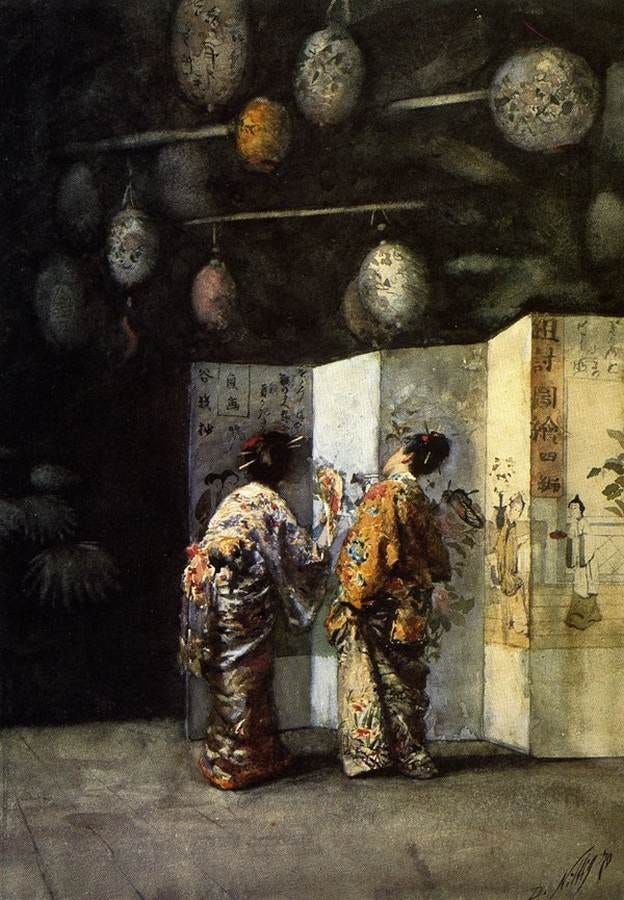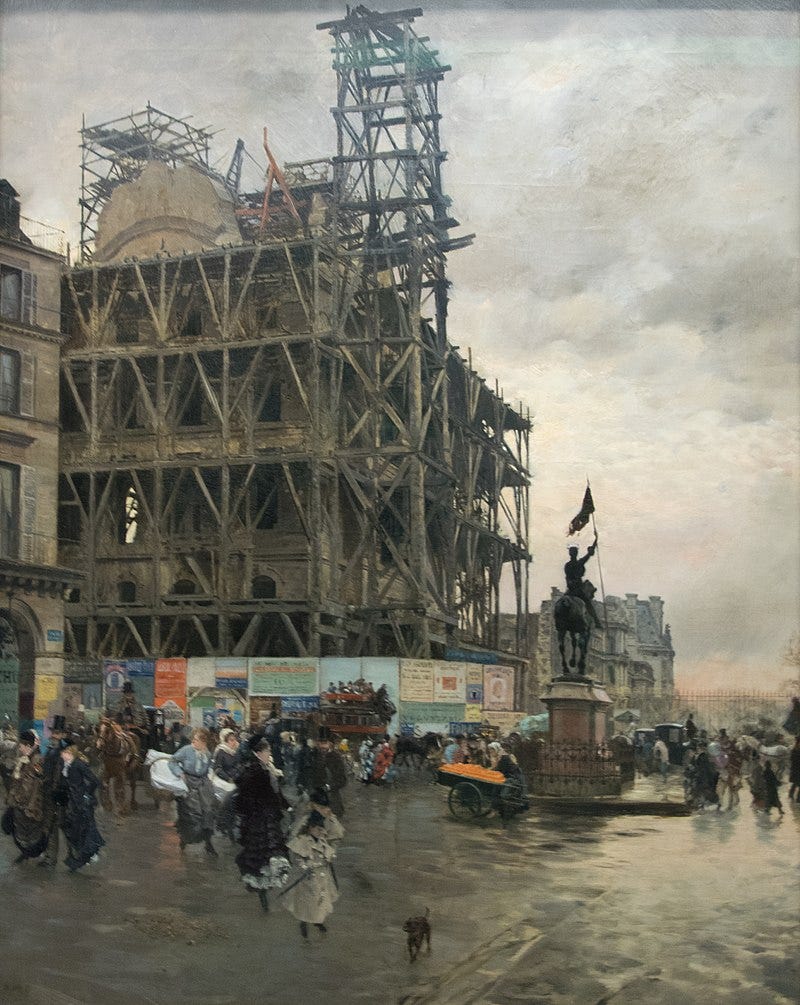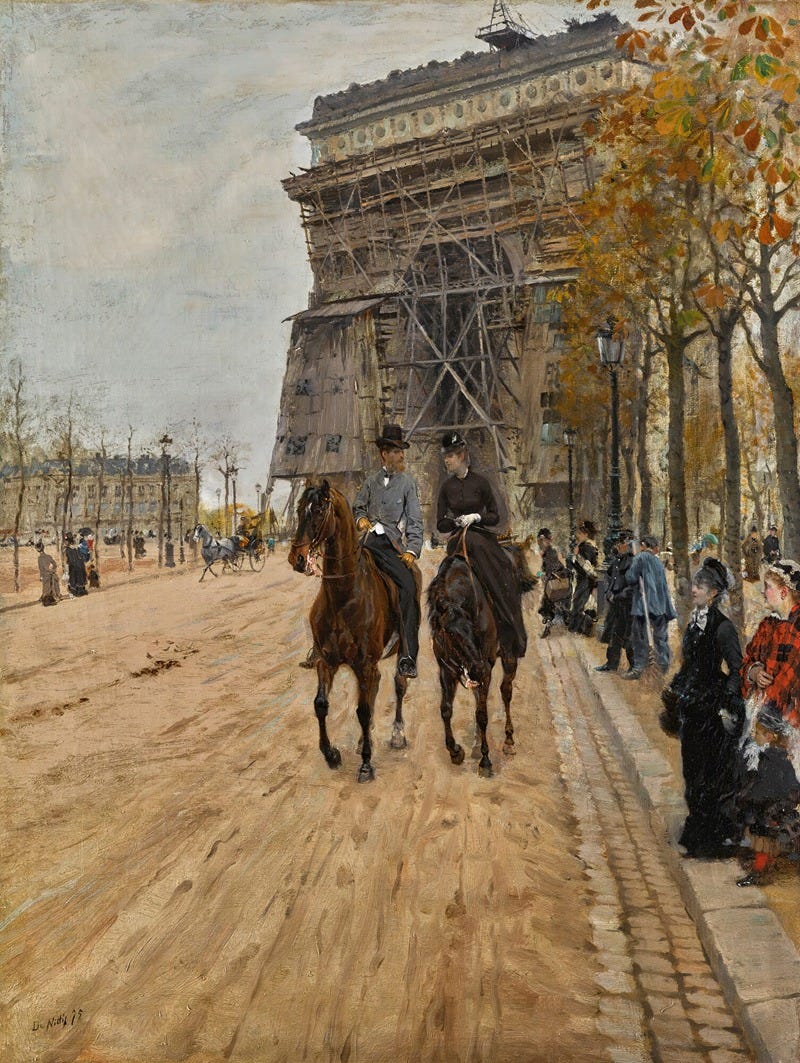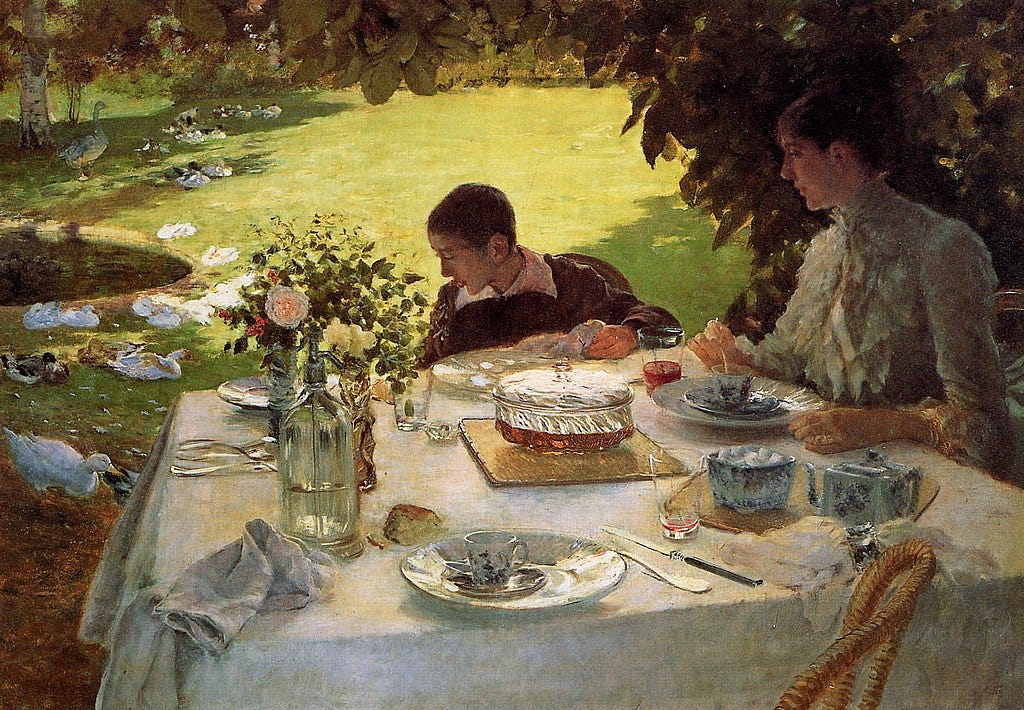Looking at the Masters: Giuseppe De Nettis by Beverly Hall Smith
Italian artist Giuseppe De Nettis (1846-1884) was born into a wealthy family in Barletta, Italy. He trained for a short time in the Italian classical style of painting. At the age of 21, he moved to Paris, the heart of the art world at the time. He was engaged by Adolphe Goupil, founder of Goupil & Cie (1850), the leading art dealer and publisher in Paris in the 19th Century, to create saleable genre paintings. His works were exhibited in the Salons, and he received a Gold Medal and was made a member of the Legion of Honor. He became a success and his work was in demand.
“Japanese Ladies Admiring a Screen” (1870)
“Japanese Ladies Admiring a Screen” (1870) (watercolor and pencil) (14’’x11’’) responded to the interest in Japanese ukiyo-e prints that were introduced to France in the 1860s. The prints were among De Nettis’s early purchases of art. The patterns of Japanese silk kimono fabrics and the lanterns and screens fascinated French patrons and artists alike. Van Gogh amassed one of the largest collections of ukiyo-e prints. The classical style of painting that De Nettis learned is obvious in his use of traditional techniques of color and light. The composition is pleasing, and a prospective buyer would have enjoyed the lavish kimonos and the patterns on the lanterns and folding screens. The small scale would have appealed to buyers with moderate funds and normal size houses.
In 1869, De Nettis married Leontine Lucille Gruvelle (1842-1913), an accomplished and beautiful woman, who often served as his model. De Nettis fled Paris for London in 1870 to avoid the Franco-Prussian War and the siege of Paris from September 1870 until January 1871. Monet, Pissarro, and Sisley were among the artists who went to London, and Degas visited his family in New Orleans. On his return to Paris, De Nettis stopped in Italy and was the first artist to depict the eruption of the Mt Vesuvius volcano.
”La Grenouillere”
When De Nettis returned to Paris in 1872, he began painting cityscapes and the people of Paris. La Grenouillere was a floating restaurant on the Seine at Croissy-sur-Seine. It was a popular gathering place for Monet, Renoir, and other Impressionists. “La Grenouillere” (1873-74) (14”x11”) is a depiction of four fashionably dressed women, walking down a stone stairway to engage a boatman to row them across to the restaurant. The day is sunny and the flowers are popping out on the hill. The women perhaps anticipate a pleasant boat ride.
Having met several of the Impressionists, De Nettis began exploring some of their techniques: painting outdoors, exploring suggestive brushstrokes, and using the colors of sunlight to create shadows. For example, the shadows on the white dress of the woman engaged with the boatman are painted blue, not gray.
Degas invited De Nettis to show his work in the first Impressionist Exhibition in 1874. His five paintings, not well liked by some of the Impressionists, were hung in a dark spot. He did not show with them again. His work continued to combine elements of both Realism and Impressionism. De Nettis’s Paris home became a popular salon for artists, poets, writers, musicians and others, including Oscar Wilde, Alexander Dumas, and Emile Zola. De Nettis often cooked “lasagne alla Barlettana,” an Italian dish that received cheers from the guests, “Viva De Nettis.”
“Le Place du Pyramids” (1875)
De Nettis also chose to paint images of the reconstruction of famous landmarks that were damaged during the Franco-Prussian War. “Le Place du Pyramids” (1875) (36”x30”) is a depiction of an iconic Parisian location. It was named in honor of Napoleon’s victory in Egypt in 1789. The statue of Joan of Arc is prominent at the center. Advertisements cover the scaffolding around the building. Parisiens going about their daily business walk through the busy square, passing by market carts, carriages, and a horse drawn bus. The sky is gray and the pavement wet. Le Place du Pyramids is in the middle of Rue de Rivoli, near the eastern end of the Tuileries Gardens.
“Arc de Triomphe” (1875)
“Arc de Triomphe” (1875) (21”x16’’) is a depiction of another well-known Paris landmark, under scaffolding for repair of damage during the Franco-Prussian War. The painting represents the resilience of the Parisiennes. It is autumn, and the tree leaves have turned orange. A wealthy couple on horseback enjoy a ride along the Champs-Elysees. They have passed under the Arc de Triomphe. De Nettis was adept at painting horses, and like Degas, he often painted the races at Longchamp. People are about to cross the road, among them a red-haired woman in a bright plaid coat, a well-dressed woman in black, and a young girl wearing red socks. The trio is probably an upper-class mother, her daughter, and a maid or nanny.
The figures are painted realistically. The avenue is created with casual brushstrokes of a variety of beiges and browns, but also blues. Across the Champs-Elysees, the horse drawn carriage, people, trees, and distant buildings are more Impressionistic. De Nettis’s use of black paint throughout the painting distinguishes him from the Impressionists.
“La parfumerie Violet, on the Boulevard des Capucines” (1880)
“La parfumerie Violet, on the Boulevard des Capucines” (1880) is a depiction of what was one of the most elegant boulevards in Paris. The Maison Violet was opened in 1827 by Francois-Etienne Violet. Famous for its fragrances, its perfumes received a great many awards and patents for their scents. The studio of the famous French photographer Felix Nadar (1820-1910) was located at 35 Boulevard des Capucines. The rich and famous came there to have their photographs taken. The studio also was the location of the first Impressionist exhibition in 1874.
“Breakfast in the Garden” (1884)
“Breakfast in the Garden” (1884) (34”x46’’) is one of De Nettis’s last works. His beloved wife Leontine and their son Jacques sit at a table in the shade of overhanging trees, and they enjoy breakfast in the sunny garden. The table is set with coffee cups, silverware, a China cream and sugar set, a vase of spring flowers, and a white tablecloth with napkins. In front of the table is an empty wicker chair where De Nettis had sat. Leontine and Jacques concentrate on a curious duck that has come close. Other ducks are on the lawn and under the shade of nearby trees. De Nettis painted a happy time with his family. His skill at painting in the Impressionist style, when he wanted to, is fully visible.
During his short career, De Nettis painted in Paris, on yearly trips to London, and while visiting Italy. He was named Knight of the Order of the Crown of Italy in 1875.
De Nettis died in 1884 at the young age of 38 from a stroke. He was honored in 1886 with a memorial exhibition at The Galerie Bernheim Jeune in Paris. Other exhibitions followed. In1984, he was honored with a 300 lire postage stamp. Since De Nettis chose to go his own way at a time when the popularity of Impressionism was on the rise, his works became eclipsed for a time. Today, his work is considered among the best of his time.
Beverly Hall Smith was a professor of art history for 40 years. Since retiring to Chestertown with her husband Kurt in 2014, she has taught art history classes at WC-ALL and the Institute of Adult Learning, Centreville. An artist, she sometimes exhibits work at River Arts. She also paints sets for the Garfield Theater in Chestertown.










